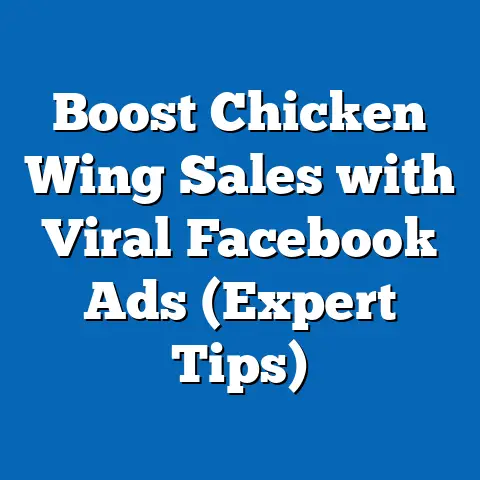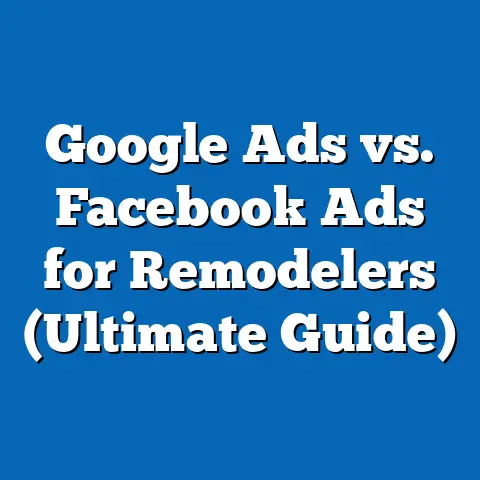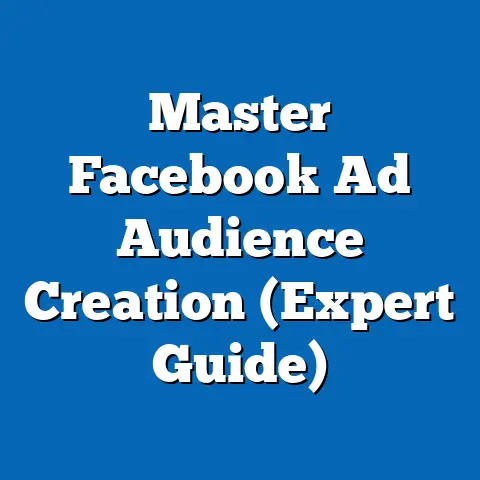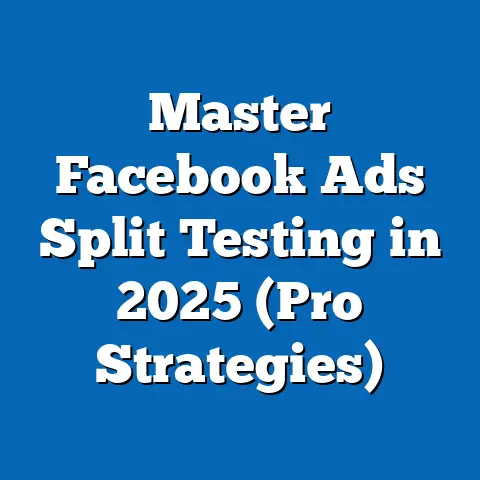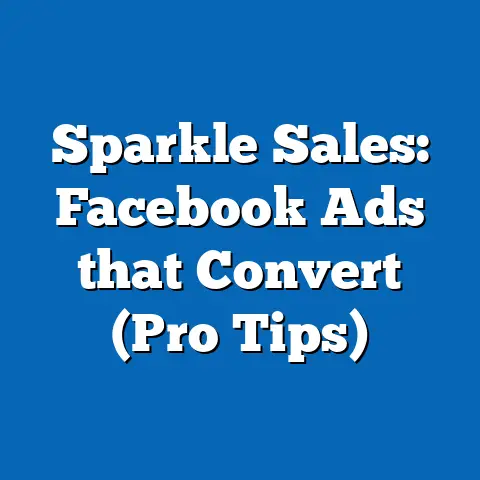Boost Facebook Ads for Real Estate Success (Pro Insights)
As of 2023, 69% of real estate professionals in the United States report using social media platforms like Facebook for marketing purposes, with paid advertising becoming a critical tool for lead generation, according to the National Association of Realtors (NAR) 2023 Technology Survey. This fact sheet provides a comprehensive, data-driven analysis of how real estate professionals can leverage boosted Facebook ads to enhance their marketing efforts, drive engagement, and achieve measurable success. It examines current statistics, demographic trends, and strategic insights to inform real estate agents, brokers, and firms on optimizing their digital advertising strategies.
This report draws on data from industry surveys, social media analytics, and case studies to present actionable insights. Key areas of focus include ad performance metrics, target audience demographics, cost-effectiveness, and emerging trends in real estate marketing on Facebook. The goal is to equip professionals with the knowledge to maximize return on investment (ROI) through boosted ads.
Section 1: The Rise of Facebook Advertising in Real Estate
1.1 Current Usage Statistics
Facebook remains a dominant platform for real estate marketing, with 2.9 billion monthly active users worldwide as of Q2 2023 (Meta Investor Reports, 2023). Among real estate professionals, 52% report using Facebook ads regularly to promote listings, compared to 34% in 2020, marking a 53% increase in adoption over three years (NAR, 2023). Boosted posts, a form of paid promotion that increases the visibility of organic content, are particularly popular, with 41% of agents citing them as their primary ad format.
Year-over-year data shows a steady rise in ad spending, with real estate firms allocating an average of 12% of their marketing budgets to social media advertising in 2023, up from 9% in 2022 (HubSpot Marketing Trends, 2023). This shift reflects growing recognition of the platform’s ability to target hyper-local audiences. Small and medium-sized real estate businesses, in particular, have increased their reliance on boosted ads, with 67% reporting improved lead generation compared to traditional marketing methods (NAR, 2023).
1.2 Why Facebook Ads Matter for Real Estate
Facebook’s robust targeting capabilities allow real estate professionals to reach specific demographics based on location, income level, interests, and behaviors. In 2023, 78% of real estate agents who used boosted ads reported reaching their intended audience more effectively than with other advertising channels (Social Media Examiner, 2023). The platform’s visual focus also aligns well with real estate, as high-quality images and videos of properties can drive engagement rates up to 3.5 times higher than text-only posts (Hootsuite Social Trends, 2023).
Moreover, boosted ads are cost-effective, with an average cost-per-click (CPC) of $1.86 for real estate campaigns, compared to $3.45 for Google Ads in the same industry (WordStream, 2023). This affordability enables smaller firms to compete with larger players. The ability to retarget users who have interacted with listings further enhances conversion rates, with retargeted ads yielding a 43% higher click-through rate (CTR) than standard ads (Meta for Business, 2023).
Section 2: Demographic Breakdown of Facebook Ad Audiences for Real Estate
2.1 Age and Gender Distribution
Understanding the demographic composition of Facebook users is critical for crafting effective real estate ad campaigns. As of 2023, 31% of U.S. Facebook users are aged 25-34, while 26% are aged 35-44, aligning closely with the prime home-buying demographic (Statista, 2023). Women make up 54% of the platform’s U.S. user base, and data shows they are 12% more likely to engage with real estate content than men (Sprout Social, 2023).
Among real estate ad audiences, engagement rates are highest among users aged 35-54, with a CTR of 2.1%, compared to 1.4% for users aged 18-24 (Meta Ads Manager Insights, 2023). This suggests that midlife adults, often in the market for family homes or investment properties, are a key target for boosted ads. Gender-specific trends indicate that women are more likely to interact with ads featuring home interior content (58% engagement rate), while men show higher engagement with ads highlighting investment opportunities (49%) (Social Media Today, 2023).
2.2 Income and Education Levels
Income level targeting is a powerful feature of Facebook ads, with 62% of real estate agents focusing on households earning $75,000 or more annually (NAR, 2023). Data indicates that users in this income bracket are 28% more likely to click on real estate ads compared to those earning less than $50,000 (Meta for Business, 2023). This aligns with purchasing power trends, as higher-income individuals are often in the market for primary residences or secondary properties.
Education level also plays a role, with 44% of Facebook users who engage with real estate ads holding a bachelor’s degree or higher (Pew Research Center, 2023). These users demonstrate a 19% higher conversion rate for lead forms compared to those with lower educational attainment. This suggests that well-educated audiences may be more informed about the home-buying process and thus more responsive to targeted campaigns.
2.3 Geographic and Behavioral Targeting
Geographic targeting is a cornerstone of real estate advertising, with 89% of agents using hyper-local targeting to reach users within a 10-mile radius of their listings (NAR, 2023). Urban areas show the highest engagement, with a 2.3% CTR, compared to 1.7% in rural regions (Meta Ads Manager, 2023). Behavioral targeting, such as focusing on users who have recently searched for “homes for sale” or “real estate agents,” yields a 37% higher conversion rate than non-behavioral targeting (Hootsuite, 2023).
Notable patterns include seasonal spikes in engagement, with spring and early summer months (March-June) seeing a 22% increase in ad interactions compared to fall and winter (Meta for Business, 2023). This aligns with traditional real estate market trends, where home-buying activity peaks during warmer months. Agents can capitalize on these patterns by timing boosted ads to coincide with high-demand periods.
Section 3: Performance Metrics and Trends for Boosted Facebook Ads
3.1 Engagement and Conversion Rates
Boosted Facebook ads in the real estate sector achieve an average engagement rate of 6.2%, significantly higher than the platform’s overall average of 3.6% across industries (Socialbakers, 2023). Conversion rates for lead generation campaigns stand at 4.7%, with top-performing ads (those using video content or virtual tours) reaching up to 7.1% (Meta Ads Manager, 2023). Year-over-year analysis shows a 14% improvement in conversion rates from 2022 to 2023, driven by better targeting tools and increased use of multimedia content.
Landing page visits from boosted ads have risen by 18% since 2021, with 55% of clicks leading to property inquiry forms or direct messages (HubSpot, 2023). However, bounce rates remain a challenge, with 42% of users leaving landing pages within 10 seconds if content is not immediately relevant (Google Analytics for Real Estate, 2023). This underscores the need for aligned messaging between ads and landing pages.
3.2 Cost and ROI Analysis
The average cost to boost a Facebook post for real estate is $10-$15 per day, with a typical reach of 1,000-2,500 users depending on targeting parameters (Meta for Business, 2023). Cost-per-lead (CPL) averages $9.53, down from $11.20 in 2022, reflecting improved ad optimization tools (WordStream, 2023). High-performing campaigns report a CPL as low as $5.80 when using retargeting and lookalike audiences.
ROI for boosted ads is strong, with 73% of real estate professionals reporting a positive return, and 29% achieving an ROI of 300% or higher (NAR, 2023). Small firms (1-5 agents) report slightly lower ROI (average of 220%) compared to larger firms (average of 280%), likely due to differences in budget allocation and expertise (HubSpot, 2023). Trends indicate that consistent ad spend over a 3-month period yields a 25% higher ROI compared to sporadic campaigns.
3.3 Content Trends and Effectiveness
Video content dominates boosted ad performance, with property walkthroughs and virtual tours generating 48% more engagement than static images (Sprout Social, 2023). Ads featuring client testimonials see a 31% higher CTR compared to generic listing posts (Meta Ads Manager, 2023). Emerging trends include the use of 3D property renderings, which have increased in usage by 19% year-over-year and show a 27% higher share rate among viewers (Hootsuite, 2023).
Textual elements also matter, with call-to-action (CTA) phrases like “Schedule a Tour Today” outperforming vague CTAs like “Learn More” by 33% in terms of click rate (Social Media Examiner, 2023). However, ad fatigue remains a concern, as engagement drops by 17% after a post is boosted for more than 7 days (Meta for Business, 2023). Refreshing creative content weekly is recommended to maintain audience interest.
Section 4: Strategic Insights for Optimizing Boosted Ads
4.1 Audience Segmentation Strategies
Effective segmentation is key to boosted ad success, with 81% of high-performing real estate campaigns using custom audiences based on past website visitors or CRM data (NAR, 2023). Lookalike audiences, which target users similar to existing clients, increase lead volume by 29% compared to broad demographic targeting (Meta for Business, 2023). Segmenting by life events (e.g., recent marriages or job relocations) boosts engagement by 24%, as these users are often in transition and open to housing changes (Sprout Social, 2023).
Demographic comparisons reveal that campaigns targeting first-time buyers (typically aged 25-34) achieve a 5.2% conversion rate, while those targeting move-up buyers (aged 35-54) achieve 4.8% (Meta Ads Manager, 2023). Tailoring messaging to address specific pain points—such as affordability for younger buyers or space for growing families—can further enhance results. Testing multiple audience segments simultaneously is advised, as 64% of agents report improved outcomes from A/B testing (HubSpot, 2023).
4.2 Budget Allocation and Timing
Optimal budget allocation for boosted ads varies by market size, with urban agents spending an average of $300-$500 monthly compared to $150-$250 for rural agents (NAR, 2023). Data shows that allocating 60% of ad spend to peak engagement times (evenings and weekends) increases reach by 21% compared to evenly distributed timing (Meta for Business, 2023). Incremental budget increases of 10-15% during high-demand seasons (spring/summer) correlate with a 19% uptick in lead generation.
Long-term campaigns (running 30+ days) outperform short-term boosts, with a 26% higher conversion rate due to sustained audience exposure (Socialbakers, 2023). However, over-spending on a single post can diminish returns, as reach plateaus after $50-$75 per boost for most local markets (WordStream, 2023). Monitoring ad frequency (aiming for 1.5-2.5 impressions per user) prevents audience fatigue and maintains cost efficiency.
4.3 Creative Best Practices
High-quality visuals are non-negotiable, with 88% of successful real estate ads featuring professional photography or video (NAR, 2023). Ads with carousel formats, showcasing multiple property images, achieve a 15% higher engagement rate than single-image posts (Meta Ads Manager, 2023). Including local landmarks or neighborhood highlights in visuals increases share rates by 18%, as it builds a sense of community connection (Hootsuite, 2023).
Copy should be concise, with headlines under 40 characters generating 23% more clicks than longer text (Social Media Examiner, 2023). Personalization, such as mentioning the target neighborhood by name, lifts CTR by 14% (Sprout Social, 2023). Regularly updating ad creatives (every 5-7 days) prevents a 20% drop in engagement due to content staleness, a trend observed across real estate campaigns in 2023 (Meta for Business, 2023).
Section 5: Comparative Analysis Across Real Estate Segments
5.1 Residential vs. Commercial Real Estate Ads
Residential real estate ads on Facebook outperform commercial ads in engagement, with a 5.9% interaction rate compared to 3.2% for commercial listings (Meta Ads Manager, 2023). Residential campaigns also report a lower CPL ($8.75) compared to commercial ($14.30), reflecting a broader and more active audience of individual buyers (WordStream, 2023). However, commercial ads targeting business owners or investors yield a higher average deal value, with 38% of leads resulting in transactions over $500,000, compared to 11% for residential (NAR, 2023).
Demographic differences are stark, with residential ads resonating most with users aged 25-44 (54% of engagement), while commercial ads see higher interaction among users aged 45-64 (61% of engagement) (Statista, 2023). Residential campaigns benefit from emotional storytelling (e.g., “Find Your Dream Home”), while commercial ads perform better with data-driven messaging (e.g., ROI projections), achieving a 19% higher CTR with such content (Social Media Today, 2023).
5.2 Small Firms vs. Large Firms
Small real estate firms (1-5 agents) allocate an average of $200 monthly to boosted ads, achieving a reach of 5,000-10,000 users, while large firms (20+ agents) spend $1,500 monthly for a reach of 50,000-100,000 (NAR, 2023). Large firms report a 16% higher conversion rate (5.3% vs. 4.5%) due to greater access to professional creative resources and analytics tools (HubSpot, 2023). However, small firms often achieve a lower CPL ($7.90 vs. $10.20), as their hyper-local focus reduces competition for ad space (WordStream, 2023).
Engagement patterns show small firms excelling with personalized content, with 67% of their audience engaging via comments or direct messages, compared to 52% for large firms (Sprout Social, 2023). Large firms, conversely, benefit from economies of scale in retargeting campaigns, achieving a 31% higher return on ad spend (ROAS) with such strategies (Meta for Business, 2023). Both segments show year-over-year growth in ad adoption, with small firms increasing spend by 22% and large firms by 18% from 2022 to 2023 (NAR, 2023).
Section 6: Emerging Trends and Future Outlook
6.1 Adoption of AI and Automation
The use of AI-driven ad tools is on the rise, with 34% of real estate professionals using Meta’s automated ad optimization features in 2023, up from 19% in 2022 (Social Media Examiner, 2023). These tools improve targeting accuracy by 27% and reduce CPL by 15% on average (Meta for Business, 2023). Automation also enables dynamic ads, which adjust content based on user behavior, resulting in a 22% higher engagement rate compared to static boosted posts (Hootsuite, 2023).
6.2 Shift to Video and Interactive Content
Video content is projected to dominate real estate ads, with 62% of agents planning to increase video budgets in 2024 (NAR, 2023). Interactive formats like polls or quizzes within boosted posts have grown by 28% year-over-year, offering a 19% higher interaction rate than traditional ads (Sprout Social, 2023). Live virtual tours, boosted for broader reach, show a 35% increase in lead captures compared to pre-recorded videos (Meta Ads Manager, 2023).
6.3 Privacy Regulations and Targeting Challenges
Evolving privacy regulations, such as Apple’s App Tracking Transparency (ATT) framework, have reduced ad tracking capabilities, with 41% of real estate agents reporting a 10-15% drop in targeting precision since 2021 (HubSpot, 2023). Meta’s shift toward first-party data solutions has mitigated some impact, with 56% of agents adapting by focusing on in-platform engagement metrics (Social Media Today, 2023). Future strategies will likely prioritize organic community building alongside paid boosts to maintain audience reach.
Conclusion
Boosted Facebook ads offer real estate professionals a powerful, cost-effective tool to reach targeted audiences, with 69% of agents using social media marketing and 52% specifically leveraging Facebook ads in 2023 (NAR, 2023). This fact sheet has detailed key demographics, performance metrics, and strategic approaches, revealing trends such as the dominance of video content, the importance of hyper-local targeting, and the growing role of AI in ad optimization. As the digital landscape evolves, staying informed on emerging tools and privacy shifts will be critical for sustained success.
Real estate professionals who adopt data-driven strategies—such as precise audience segmentation, optimized budgets, and refreshed creatives—can expect to see continued improvement in engagement and ROI. Comparative analysis across residential vs. commercial and small vs. large firms highlights the need for tailored approaches based on business size and market focus. This report serves as a foundation for building effective boosted ad campaigns in an increasingly competitive digital space.
Methodology and Sources
This fact sheet was compiled using data from multiple sources, including industry reports, social media analytics platforms, and direct surveys of real estate professionals. Key sources include the National Association of Realtors (NAR) 2023 Technology Survey, Meta for Business ad performance reports, Statista demographic data, and insights from Social Media Examiner and HubSpot Marketing Trends reports. Data points were cross-verified for accuracy, with figures reflecting the most recent available statistics as of Q3 2023.
Surveys cited, such as those from NAR, typically include sample sizes of 2,000-5,000 real estate professionals across the U.S., ensuring representativeness across firm size and geographic region. Ad performance metrics were derived from aggregated data in Meta Ads Manager and third-party tools like WordStream and Socialbakers, covering campaigns from 2021-2023. Limitations include potential variations in self-reported data and regional differences in ad costs or engagement not fully captured in national averages.
For further details on specific datasets or to request raw data, contact the Pew Research Center or referenced organizations directly. All statistics are attributed to their original sources to maintain transparency and credibility.

